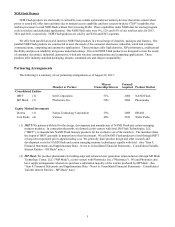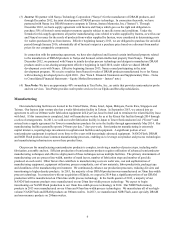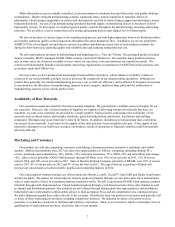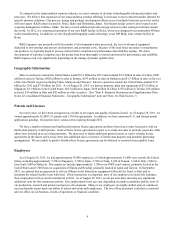Crucial 2013 Annual Report Download - page 9
Download and view the complete annual report
Please find page 9 of the 2013 Crucial annual report below. You can navigate through the pages in the report by either clicking on the pages listed below, or by using the keyword search tool below to find specific information within the annual report.8
Backlog
Because of volatile industry conditions, customers are reluctant to enter into long-term, fixed-price contracts. Accordingly,
new order volumes for our semiconductor products fluctuate significantly. We typically accept orders with acknowledgment
that the terms may be adjusted to reflect market conditions at the date of shipment. For these reasons, we do not believe that
our order backlog as of any particular date is a reliable indicator of actual sales for any succeeding period.
Product Warranty
Because the design and manufacturing process for semiconductor products is highly complex, it is possible that we may
produce products that do not comply with customer specifications, contain defects or are otherwise incompatible with end
uses. In accordance with industry practice, we generally provide a limited warranty that our products are in compliance with
our specifications existing at the time of delivery. Under our general terms and conditions of sale, liability for certain failures
of product during a stated warranty period is usually limited to repair or replacement of defective items or return of, or a credit
with respect to, amounts paid for such items. Under certain circumstances, we provide more extensive limited warranty
coverage than that provided under our general terms and conditions.
Competition
We face intense competition in the semiconductor memory market from a number of companies, including Samsung
Electronics Co., Ltd.; SanDisk Corporation; SK Hynix Inc.; Spansion Inc. and Toshiba Corporation. Some of our competitors
are large corporations or conglomerates that may have greater resources to withstand downturns in the semiconductor markets
in which we compete, invest in technology and capitalize on growth opportunities. Our competitors seek to increase silicon
capacity, improve yields, reduce die size and minimize mask levels in their product designs resulting in significantly increased
worldwide supply and downward pressure on prices. Many of our high-volume memory products are manufactured to industry
standard specifications and as such have similar performance characteristics to those of our competitors. For these high-
volume memory products, the principal competitive factors are generally price and performance characteristics including:
operating speed, power consumption, reliability, compatibility, size and form factors. For our other memory products, the
aforementioned performance characteristics generally take precedence to pricing.
Research and Development
Our process technology R&D efforts are focused primarily on development of successively smaller line-width process
technologies, as well as new fundamentally different memory structures, materials and packages, which are designed to
facilitate our transition to next generation memory products. Additional process technology R&D efforts focus on the
enablement of advanced computing and mobile memory architectures, the investigation of new opportunities that leverage our
core semiconductor expertise and the development of new manufacturing materials. Product design and development efforts
include our high density DDR3 and DDR4 DRAM and Mobile Low Power DDR DRAM products as well as high density and
mobile NAND Flash memory (including MLC and TLC technologies), NOR Flash memory, specialty memory, SSDs, hybrid
memory cubes and other memory technologies and systems.
Our R&D expenses were $931 million, $918 million and $791 million in 2013, 2012 and 2011, respectively. We generally
share R&D process and design costs for NAND Flash with Intel. We also share R&D costs for certain emerging memory
technologies with Intel. We generally shared R&D process and design costs for DRAM with Nanya through December 2012,
when our cost-sharing agreement was terminated. As a result of reimbursements under our Intel and Nanya cost-sharing
arrangements, our overall R&D expenses were reduced by $146 million, $225 million and $236 million in 2013, 2012 and
2011, respectively.






















